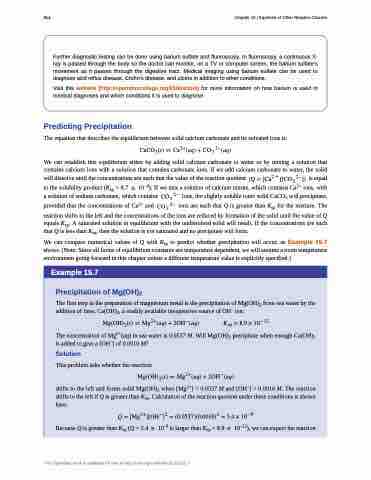Page 824 - Chemistry--atom first
P. 824
814
Chapter 15 | Equilibria of Other Reaction Classes
Further diagnostic testing can be done using barium sulfate and fluoroscopy. In fluoroscopy, a continuous X- ray is passed through the body so the doctor can monitor, on a TV or computer screen, the barium sulfate’s movement as it passes through the digestive tract. Medical imaging using barium sulfate can be used to diagnose acid reflux disease, Crohn’s disease, and ulcers in addition to other conditions.
Visit this website (http://openstaxcollege.org/l/16barium) for more information on how barium is used in medical diagnoses and which conditions it is used to diagnose.
Predicting Precipitation
The equation that describes the equilibrium between solid calcium carbonate and its solvated ions is:
�������� � �������� � ��� ������
We can establish this equilibrium either by adding solid calcium carbonate to water or by mixing a solution that contains calcium ions with a solution that contains carbonate ions. If we add calcium carbonate to water, the solid will dissolve until the concentrations are such that the value of the reaction quotient �� � ���� � ����� ���� is equal
to the solubility product (Ksp = 8.7 � 10–9). If we mix a solution of calcium nitrate, which contains Ca2+ ions, with a solution of sodium carbonate, which contains ��� �� ions, the slightly soluble ionic solid CaCO3 will precipitate,
provided that the concentrations of Ca2+ and ��� �� ions are such that Q is greater than Ksp for the mixture. The
reaction shifts to the left and the concentrations of the ions are reduced by formation of the solid until the value of Q equals Ksp. A saturated solution in equilibrium with the undissolved solid will result. If the concentrations are such that Q is less than Ksp, then the solution is not saturated and no precipitate will form.
We can compare numerical values of Q with Ksp to predict whether precipitation will occur, as Example 15.7 shows. (Note: Since all forms of equilibrium constants are temperature dependent, we will assume a room temperature environment going forward in this chapter unless a different temperature value is explicitly specified.)
Example 15.7
Precipitation of Mg(OH)2
The first step in the preparation of magnesium metal is the precipitation of Mg(OH)2 from sea water by the addition of lime, Ca(OH)2, a readily available inexpensive source of OH– ion:
���������� � �������� � �������� ��� � ��� � �����
The concentration of Mg2+(aq) in sea water is 0.0537 M. Will Mg(OH)2 precipitate when enough Ca(OH)2
is added to give a [OH–] of 0.0010 M? Solution
This problem asks whether the reaction:
���������� � �������� � ��������
shifts to the left and forms solid Mg(OH)2 when [Mg2+] = 0.0537 M and [OH–] = 0.0010 M. The reaction shifts to the left if Q is greater than Ksp. Calculation of the reaction quotient under these conditions is shown here:
� � ������������ � ����������������� � ��� � ����
Because Q is greater than Ksp (Q = 5.4 � 10–8 is larger than Ksp = 8.9 � 10–12), we can expect the reaction
This OpenStax book is available for free at http://cnx.org/content/col12012/1.7


